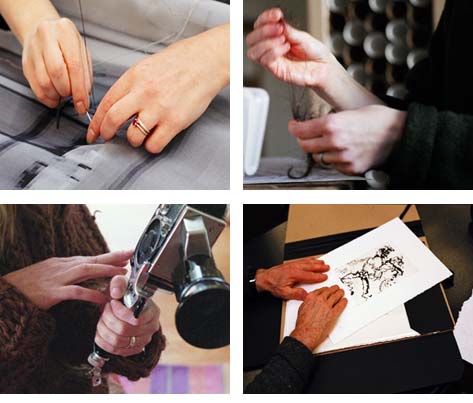Art under siege
Author: Gordana Zivkovic
Camera, technical assistance
&
text: Marko Zivkovic
Group exibition “Art Inter/national: here and abroad.” Boxheart gallery Pittsburg, PA 15224, January 2005
![]() "
ART UNDER SIEGE
"
movie [ 3.5MB ]
"
ART UNDER SIEGE
"
movie [ 3.5MB ]
Extreme close up and extreme slow motion act as a time/space loupe that makes ordinary objects mysterious. Our senses are shocked by this opening up of otherwise unseen realms. There is something uncanny in the fact that revealing much more about an object than we ordinarily perceive makes it at the same time more mysterious. Blowing them out of the scales of our normal space/time perception these old cinematic devices tend to make ordinary objects into ciphers, hieroglyphics. Artist's hands as hieroglyphs, and the very shocking of perception out of its everyday grooves as an embodied template for one of the things art does to us – training the mind-muscles of transcendence.
Works of art can cast a magic spell over the beholder. Masterfully carved prows of Trobriand canoes were believed to so awe and dazzle the partner in Kula exchange that he would take leave of his senses and easily give up his most precious valuables. Religions dazzled with monumental architecture and kings commissioned great art to enhance their charisma. The enchantment of art objects came from the display of virtuosity that must have appeared magical to the uninitiated. Powers that be usually wanted to have art on their side to awe, to dazzle to sway the minds. That doesn't mean that that the power of art objects accrued to individual artists who made them. Most often than not, the art enhanced the power of the patron, not the creator. Nor was the creativity, unique individuality, or originality of the individual artist always and everywhere respected or even acknowledged. Our Modern Occidental notions of creative genius have particular historical roots (whether we trace them back to Greece, Renaissance or Romanticism). So too does our notion of high art as a crucial part of High Culture. High Culture, and thus high art, became a sign of spirituality, sublimity, of the highest achievements humanity was capable of. And in the age of nations, accomplishments in high art became emblems of national pride. Thus to be protected, encouraged, and yes, financed by national states. A hierarchy emerged with Academies, where living immortals abided, at the apex. In Japan, master artists and craftsmen achieve the status of
"
living national treasures.
"
Superiority of your ballet, or symphonies, or painting, or literature become proofs of the superiority of your nation state, your race, your Civilization, or your Ideology.
If at any point art was secure in its position of an undisputed Good, parallel to, or even substituting for Religion, this is no longer the case. Together with the vestiges of the old awe and pious respect, there is an ever stronger sense today that art is a mere ornament, a luxury, of no real consequence. The elitism of high art is denounced, low and high blurred, the aura of the original dissipated by the inundation of mechanically (and electronically) reproduced copies. Life and art merge, the author is proclaimed dead. Leonardos of today work in advertising, professors write books on the Death of Art. As always, there are Lamenters and Rejoicers. Art should ride the currents of commercialism, it has never been better for art Rejoicers, exclaim exultantly. Markets are good for art (the old survival of the fittest), the death of art, of high versus low, of craftsmanship, and originality is liberating. Lamenters lament: the cuts in funding, the loss of status, the disappearance of values and standards.
This project aims neither to Lament nor to Rejoice, but to sense the currents of the Here and Now, and to give them form through focusing on the figure of the artist. If the identity of art is in flux, it is the artists who feel it viscerally (whether as elation or anxiety, most probably both). Their questions about who they are in today's world are what we want to attend to.

Artists presented in the video: Gerri Ondrizek, Linda Kliewer, Stephanie Snyder, Sam Gold, Tom Kearcher, Diane E. Jacobs, Cynthia D. Lathi, Barb Tetenbaum, Inge Bruggeman and MK Guth (all working in Portland, Oregon)
you live wherever you live
you do whatever work you do
you talk whatever you talk
you eat whatever you eat
you wear whatever clothes you wear
you look at whatever image you see..
you're living however you can
you are whoever you are
"
identity
"
...
of a person
of a thing
of a place
"
identity
"
...
the word itself gives me shivers
it rings of calm, comfort, contentedness
What is it , identity?
To know where you belong
to know your self worth
to know who you are
how you recognize identity?
we are creating an image of ourselves
we are attempting to resemble this image...
is that what we call identity
the accord between the image
we have created of ourselves
and ourselves..?
Just who is that
"
ourselves
"
We live in the cities
the cities lives in us...
Time passes..
We move from one city to another,
from one country to another.
We change languages,
we change habits,
we change opinions,
we change clothes,
we change everything ,
everything changes
and fast.
Images above all change faster and faster
Wim Wenders, Prologue to his 1989 film Notebook on Cities and Clothes
Images of artists. What would it be like to create images of artists, images they have of themselves, images others have of them? We want to create these images. These images will be images of our world.
The Project will involve Portland and Belgrade artists